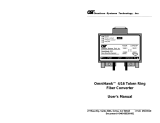Page is loading ...

Omnitron Systems Technology, Inc. 1
OmniRepeater
TM
400
Systems AS400/3X 5250
and 5250 Express Twinax
Fiber Converter
User’s Manual
27 Mauchly #201, Irvine, CA 92618; (949) 250-6510, Fax: (949) 250-6514
Document #040-02651-001
NOTES:

2 Omnitron Systems Technology, Inc.
SAFETY CONSIDERATIONS
Warning
The instructions in this User’s Manual are for use by qualified personnel only. To avoid electrical
shock, do not perform any servicing of this unit or its accessories (such as power units) other
than that contained in the operating instructions, unless you are qualified and certified to do so by
Omnitron Systems Technology, Inc.
Caution
All user-required operations can be performed without ever opening the unit’s cover. Never attempt
to open or remove the unit’s cover or tamper with its power units (other than plugging and unplugging
them as specified in the operating instructions).
Line Voltage
Before Connecting the Power units to the line voltage, make sure that the voltage of the power
source (wall outlet) matches the voltage specified on the power units.
Warranty
This
OST
product is warranted to the original purchaser against defects in material and
workmanship for a period of
TWO YEARS
from the date of shipment. This warranty period may
be extended to
LIFETIME
by the original purchaser if the product is
REGISTERED
with
OST
within 90 days from the date of shipment. TO REGISTER, PLEASE COMPLETE AND MAIL OR
FAX BACK THE REGISTRATION CARD. During the warranty period,
OST
will, at its option,
repair or replace a product which is proven to be defective.
For warranty service/repair, the product must be sent to an
OST
designated repair facility, shipment
prepaid by the Buyer.
OST
will pay postage/shipping charges to return the product to Buyer
(using
OST’
s standard shipping method).
Limitation of Warranty
The foregoing warranty shall not apply to defects resulting from improper or inadequate use and/
or maintenance of the equipment by Buyer, Buyer-supplied equipment, Buyer-supplied interfacing,
unauthorized modifications or tampering with equipment (including removal of equipment cover
by personnel not specifically authorized and certified by
OST
), misuse, operating outside the
environmental specification of the product (including but not limited to voltage, ambient temperature,
radiation, unusual dust, etc.), or improper site preparation or maintenance.
No other warranty is expressed or implied.
OST
specifically disclaims the implied warranties of
merchantability and fitness for any particular purpose.
Exclusive Remedies
The remedies provided herein are the Buyer’s sole and exclusive remedies.
OST
shall not be
liable for any direct, indirect, special, incidental, or consequential damages, whether based on
contract, tort, or any legal theory.
Form:040-02651-001 07/00
Omnitron Systems Technology, Inc. 7
SPECIFICATIONS
n Protocol: IBM 5250 and 5250 Express for systems AS/400 and 3X
n Devices Supported: All twinax/IBM compatible devices (terminals and
printers)
n Interface:
Link: One (1) Twinax, One (1) Fiber or
One (1) Rj11/45, One (1) Fiber
Port: One (1) Twinax or
One (1) Rj11/45
(RJ11 pins 3-4, RJ45 pins 4-5 are standard)
n Cable Types:
Twinax: IBM 7362229 or equivalent
UTP: Category 3 (EIA/TIA 568) or higher
(shorter distance @ lower grade)
n Data Rate:
Standard 5250: 1 Mbps -2%, +4%
5250 Express: 1 or 2 Mbps -2%, +4%
n Supported Distances:
Host/Device to Mux:
Twinax: 5,000 ft.
UTP: 3,000 ft.
Multimode fiber: 15,000 ft.
Single-mode fiber: 30,000 ft.
n Physical Dimensions:
Rackmount: W:19.0”xD:6.0”xH:1.75”
Tabletop: W:17.5”xD:6.0”xH:1.75”
n Weight: 7 lbs.
n Power: 115 or 230 VAC, 100/50 mA
n Temperature:
Operating: 0° to 40°C
Storage: -40° to 75°C
Humidity: Up to 90% (non-condensing)
TECHNICAL SUPPORT
For assistance in installing this product, contact Omnitron’s Technical Support
Department.
Phone: (949) 250-6510
Fax: (949) 250-6514
Address: Omnitron Systems Technology, Inc.
27 Mauchly #201
Irvine, CA 92618, USA
Email: [email protected]
URL: www.omnitron-systems.com

Omnitron Systems Technology, Inc. 3
GENERAL DESCRIPTION
The OmniRepeater 400 is an IBM 5250 compatible Repeater and Fiber Converter/
Modem device that provides true data repeating and media conversion functionality.
It provides re-timing, reshaping and regeneration of 5250 data. As a media
converter it provides modulation and conversion from/to twinax anda fiber (both
single and multimode). The following models are discussed in this manual:
STANDARD EXPRESS DESCRIPTION
2651 2661 Twinax to Twinax and Fiber
2653 2663 Twinax to Twinax Only
The OmniRepeater 400 may be used in pairs to convert from fiber to twinax and
back, or in combination with a fiber star which will provide direct distribution of
5250 data to individual devices.
The OmniRepeater 400’s diagnostic features make it easy to install and maintain.
It detects and reports true data activity, line quality and parity errors. This is
accomplished by individual port monitoring and searching for legal sync and frame
header patterns. Upon detection of a valid frame pattern, a per port green LED
indicator displays the detected activity. This feature assists in installation and in
the detection of potential line problems. The port data is analyzed for correct
parity, and errors are indicated by a red LED. This feature facilitates the continuous
monitoring of signal and line quality.
The OmniRepeater 400 utilizes a Digital Phase Locked Architecture. Combined
with its repeating, regenerating and reshaping features, it delivers an unmatched
level of performance and reliability. The Data Frame Regeneration and Sync Bit
Reconstruction features facilitate the configuration of the OmniRepeater400 with
other Omni 400 series products for complex site configurations.
OmniRepeater
TM
400
Systems AS400/3X 5250 and
5250 Express Twinax Fiber Converter
User’s Manual
6 Omnitron Systems Technology, Inc.
CONNECTING THE HOST SIDE
Twinax
When installing the twinax host connection, the standard IBM twinax cable
should be connected to the Host/Device port of the OmniRepeater 400 unit.
Observe and monitor the port’s Activity green LED for at least 10 seconds. The
LED blinking indicates that the host is attempting to poll the devices connected
to it and that the host link quality is adequate.
No LED blinking within 10 seconds might indicate a faulty or miswired cable, too
long a cable run, or an incompatible balun (different pin configuration). A red LED
blinking might indicate either an impedance mismatch (too many twinax segments,
poor cable quality), or too long a cable distance.
CONNECTING LINK PORTS
Once the host connection is established and the host Activity LED is blinking, Link
port can be connected. If the unit is to be utilized as a Fiber Converter/modem,
Link 0 should be utilized. If the unit is to utilized as a Twinax repeater, Link 1
should be utilized. The unit will self-sense and configure itself for the appropriate
operation automatically based on the data flow.
Operation as a Twinax Repeater
Connect devices on the Link 1 side via standard twinax or cascade to another
OmniRepeater 400 or an OmniStar 400 for actual UTP device connectivity.
Operation as a Fiber Converter (Host End)
Connect both the fiber Link 0 connectors at the host end, notice and record the Rx
and Tx connections. These will need to be crossed at the distant end.
Operation as a Fiber Converter (Distant End)
Connect both fiber Link 0 connectors from the host end. Make sure to connect
theRx host cable to the Tx distant connector and the Tx host cable to the Rx
distant connector. Link 0 Activity LED should start to indicate host polling
approximately each 10 seconds. If no Activity is observed, fiber cables might be
defective or not connected properly.
Connect Twinax Host/Device port to devices, and make sure to properly terminate
the last device. When a device is connected, a green LED should indicate activity
and device should display a sign-on screen or device on-line status.
If still no LED blinking is observed within 20 seconds, that might indicate faulty or
mis-wired cable, or too long a cable run. If the red LED blinks, that might indicate
either an impedance mismatch, missing termination, or too long a cable distance.

4 Omnitron Systems Technology, Inc.
OPERATION
Inputs
The OmniRepeater 400 is built around the Digital Phase Locking Architecture. It
allows monitoring and processing of data signals at each individual port, thus
discriminating between true data and noise. The incoming Manchester encoded
data is oversampled at a rate of 16 samples per bit cell. This sampling rate is
instrumental in the digital filtering of noise. A unique clock extraction technology
utilizing dual clock oscillators facilitates the synchronization and frequency locking
from 980 Khz to 1.04 Mhz.
Processing
Once the data has been recovered and synchronized, it is processed internally
for verification of legitimacy. The processor analyzes the frame header; it expects
at least 3 sync bits followed by a Code Violation. When legal frame header is
detected, the port is “declared” active and the data frame is accepted for
retransmission.
Outputs
The retransmitted data frame is fully regenerated and reclocked. Any lost sync
bits are regenerated; the data is reclocked at a 50% duty cycle, thus completely
eliminating the effect of any accumulated phase shift or jitter. The regenerated
signal amplitude is restored to its nominal value and the pre-distortion logic pre-
compensates for anticipated phase shift and attenuation.
Displays
True data signal activity is displayed by a per port green LED. The data parity
errors are displayed by a red LED. While the Activity LED assists in detecting
connectivity, signal strength and polarity inversion problems, the Error LED assists
in detecting connectivity quality, signal strength, impedance mismatches,
discontinuities and signal reflection problems. As such, these two indicators help
in the installation and maintenance of the repeater.
INSTALLATION
Unpacking
a. Visual Inspection – Before unpacking, a visual inspection should be conducted
in order to detect any physical damage to the equipment. Any evidence of the
damage should be noted and reported immediately.
b. Unpacking – Place shipping container on a flat surface, cut straps or tape,
open top. Take out each item carefully and place securely on a clean flat surface.
Return all packing material into a container (foam, boxes, etc.), close and
store away for future reuse.
c. Inspection – Inspect each item for any apparent damage, any evidence of
damage should be noted and reported immediately.
Omnitron Systems Technology, Inc. 5
Mounting
Secure the OmniRepeater 400 chassis to either a flat surface (if tabletop) or to a
standard 19” rack if rack-mountable.
Power-Up
In order to minimize the possibility of accidental power shut off to the
OmniRepeater 400, no power switch has been designed into the product.
Special care must be taken when applying power to the OmniMux unit.
WARNING
The OmniRepeater unit does not have a power switch,
so extra care must be taken in powering the unit.
Always plug the Power Adapter into the back of
the Mux unit first. This is in order to prevent
damage to the Mux unit and to prevent potential
shorts, sparks, and fire hazards.
Verify that the power supply voltage (by reading the label on each power adapter unit)
is consistent with the facility’s line voltage (115/230 Volts), and that the Power
Adapter plug fits in the outlet.
Plug the power adapter’s cable connector to the appropriate matching connector
in the back of the OmniRepeater 400.
Plug the power a dapter into the wall outlet. Observe that all LED’s light up for
approximately 0.5 seconds. After 0.5 seconds, all should extinguish except the
yellow power LED; It stays On.
d. Content – Review the content; the following items should be included:
(a) OmniRepeater 400 Unit
(b) One (1) Power Unit
(c) User Manual (this document)
e. Please note any missing items or discrepancies and report them
immediately.
SITE REQUIREMENTS
Power
A power outlet 115 Volts/60 Hz (230 Volts/50 Hz) should be available within 5 ft. of
the unit.
Cabling
a. Twinax Host/Device Side - Use standard IBM 7362229 or equivalent.
b. Fiber Optic Link 0 Side - Use ST connector.
c. Twinax Link 1 Side - Use standard IBM 7362229 or equivalent.
/












